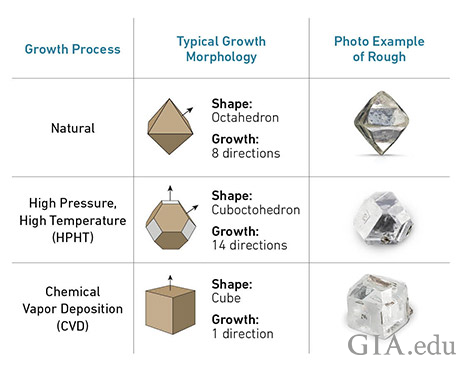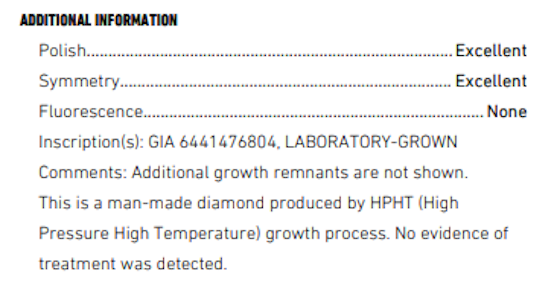July 18, 2024
CVD vs. HPHT Lab Grown Diamonds: What’s the Difference?

If you own a lab-grown diamond or are simply searching for a lab-grown diamond engagement ring, you may be wondering how lab diamonds are made. Lab-grown diamonds can be made from two processes: HPHT (High-Pressure High Temperature) method or the CVD (Chemical Vapor Deposition) method. But what are the differences between these two methods?
The HPHT (High Pressure High Temperature) Lab Diamond Growing Method
The HPHT method is the original method of creating lab-grown diamonds. Gem quality HPHT diamonds were introduced in the 1950s. Outside of growing diamonds, the HPHT process can also be used to enhance the color of diamonds to make them colorless, pink, green, blue, or yellow.
To grow an HPHT diamond, a small diamond seed is placed in carbon, the element that diamonds are made of. The diamond seed is exposed to extreme heat and pressure, replicating the way diamonds are naturally grown underground by the earth. The diamond seed is exposed to temperatures of over 2,000 degrees Fahrenheit and pressure of about 1.5 million PSI (pounds per square inch). The carbon melts and forms a diamond around the seed. It is then cooled and the diamond is formed.
A rough HPHT diamond forms differently than a rough CVD diamond. HPHT diamonds grow into a cuboctahedron, while CVD diamonds grow into a cube-like shape.

HPHT diamonds are more likely to have a yellowish hue because they are exposed to nitrogen while forming. They also tend to have darker inclusions, which are metallic. These metallic inclusions can help scientists identify them as lab-grown because naturally formed diamonds rarely capture metals during formation.
The metallic inclusions in HPHT diamonds can make the stones magnetic. This is another way to tell if a diamond is lab-grown – natural diamonds are not magnetic. A 2012 study revealed that over half of the HPHT diamonds tested registered a detectable magnetic response.
HPHT diamonds occasionally have what is called a "blue nuance." This gives the diamond a subtle blue hue.
Above: an HPHT lab diamond with a blue nuance
This blue color is a result of the boron impurities that HPHT diamonds can be exposed to. Boron is also what creates fancy blue diamonds. Make sure to view HD images and/or videos of your diamond to see if it has a blue nuance.
Learn More About the Blue Nuance in HPHT Diamonds
Are HPHT Diamonds Real?
Yes! Diamonds grown via the HPHT method are real diamonds, and will test as a diamond when a diamond tester is used. Diamonds grown through the HPHT method in a laboratory are identical to natural diamonds both chemically, physically, and optically.
module
How Do I Know If I Have An HPHT Lab-Grown Diamond?
You'll have to consult your diamond's grading report to see if it is an HPHT lab-grown diamond. Grading reports should list how the diamond was grown under the Additional Information section. Below is an example of a GIA report that identifies a lab-grown diamond as being formed through the HPHT method.
The CVD (Chemical Vapor Deposition) Lab Diamond Growing Method
The CVD method was created in the 1980s, making it newer than the HPHT method. The CVD method imitates how diamonds form in interstellar gas clouds. The CVD method uses less pressure than the HPHT method as well as smaller machines.
The CVD method places a diamond seed in a vacuum chamber. This chamber becomes filled with carbon-rich gases and is heated to nearly 1500 degrees Fahrenheit. The gas turns into plasma from these extremely high temperatures, causing the release of carbon pieces. These carbon pieces become layered onto the diamond seed, which grows the diamond.
The CVD process produces Type IIA diamonds, which are extremely rare for naturally occurring diamonds. This can help scientists determine if a diamond is lab-grown or earth-grown. Type IIA diamonds are the most chemically pure diamonds – they lack nitrogen and/or boron impurities, unlike HPHT diamonds that are exposed to nitrogen. CVD diamonds are not magnetic like HPHT diamonds can be.
RELATED: What are Type IIA Diamonds?
Are CVD Diamonds Real?
Absolutely! A diamond grown through the Chemical Vapor Deposition method will still test as a diamond. Lab diamonds grown through the CVD method are physically, optically, and chemically identical to natural diamonds.
How Do I Know If I Have a CVD Lab-Grown Diamond?
You'll need to have your diamond's grading report handy. Look under the "Additional Information" section. The report should list how the diamond was grown. Below is an example of an IGI report that verified that the diamond was grown through the CVD process.

What is better: CVD or HPHT diamonds?
You will not be able to tell the difference between a CVD and HPHT diamond with the naked eye. Both methods can create a beautiful, sparkling diamond. Both the CVD method and the HPHT method will create a real diamond that is optically, chemically, and physically identical to earth-grown diamonds.
Up Next: Do Lab-Grown Diamonds Test as Real Diamonds?





